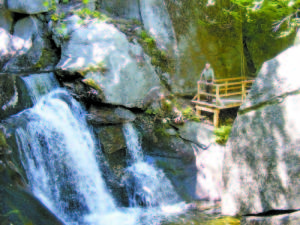Earth Notes: Lost Streams of Consciousness

LOST RIVER — A view of Lost River Gorge in Kinsman Notch, N.H., which writer Frank Daggett visited this week.
By Frank Daggett
This week, I visited the Lost River Gorge in nearby Kinsman Notch, New Hampshire. With my wife, I descended and re-climbed 300 feet, following the plunging stream that dives under glacial boulders and re-appears, often creating spectacular waterfalls and, over the course of at least 10 millennia, carving out granite cauldrons.
Following the thousand steps and the wooden decks of the boardwalk, we were within and yet apart from the natural setting. We marveled at several gnarled pines, particularly one, which framed three sides of a square.
Well over 10,000 years ago, all animal life and vegetation was gone from here, bulldozed away by a mile-thick glacier which ripped gigantic boulders from the mountain above, sending them plunging down into this deep ravine. As the ice melted, lichens and mosses took hold on decaying rock and, over many centuries, built up the soil and gave way to other species, including the pines, as life inexorably reclaimed this place.
The three-segment pine was but a recent example of life’s tenacity. Appearing to grow right out of a boulder, the trunk emerged from the bottom of a small root ball, descending several inches before veering off horizontally for a foot or two; then once again made a sudden shift to the vertical and rose 20 feet into the sunlight. Apparently, maybe a decade ago, a seed found enough detritus atop that boulder to begin to grow. Then, winter ice toppled the sapling, which turned and grew toward the light again before, maybe a couple winters more, being toppled again. Undaunted, the trunk turned and soared into the sky, its twisted roots stubbornly clinging to the rock like a kelp holdfast.
The struggle of that pine to hang on to life is no less dramatic than the swift plunging of the water or the glacial reshaping of the landscape. Here, nature proceeds simultaneously on three distinct timescales: by human standards, the fleeting descent of each droplet of water measured in minutes; the growth of the trees measured in years; and the formation of the gorge and its surrounding landscape, not measured at all by humans, its age only inferred out of seeming timelessness. Yet from a cosmological perspective, even the slow grinding of multiple waves of glaciers passed as quickly as the water falling over the rocks.
No less of a marvel is the boardwalk that permits one to see the natural wonders close up, without too much trouble, and without trampling the lichens and mosses that colonize the stone. Human consciousness is like the river that flows here, billions of individual droplets making up one torrent. Occasionally, its stream goes into the darkness, into caverns of selfishness, violence, greed and oppression. Eventually, the stream emerges into the light. Water can only flow downward. Trees can only grow up. People choose whether to go down or to go up; they choose which dark caverns to crawl through, and which to avoid.
Likewise, we choose whether to use technology to enhance or diminish our environment. Our choice, though, is only temporary; our timescale is short. In a blink of geology’s eye, just four centuries ago, Francis Bacon wrote that, “Nature cannot be commanded except by being obeyed.†It’s a truth we seem to have forgotten, but a truth upon which our future depends.

